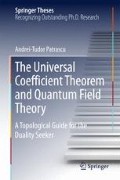Abstract
Let me start this chapter with a simple why-question: Why general topology? What is the main problem it wishes to solve? The answer is deceivingly simple: general topology aims at analyzing and describing topological spaces.
‘Would you tell me, please, which way I ought to go from here?’
‘That depends a good deal on where you want to get to.’
‘I don’t much care where -’
‘Then it doesn’t matter which way you go.’
Lewis Carroll, Alice in Wonderland
Access this chapter
Tax calculation will be finalised at checkout
Purchases are for personal use only
References
S.A. Morris, Topology Without Tears, Online e-book (2007)
S.C. Kleene, Introduction to metamathematics, North-Holland (1959). ISBN-13: 978-0923891572
M. Hazewinkel, Axiomatic method, Encyclopedia of Mathematics (Springer, Berlin, 2001). ISBN 978-1-55608-010-4
R. Haag, D. Kastler, An algebraic approach to quantum field theory, J. Math. Phys. 5, 848 (1964)
G.F. Simmons, Introduction to Topology and Modern Analysis (McGraw Hill Book Company, New York, 1968) p.144. ISBN 0-89874-551-9
A. Hatcher, Notes on Introductory Point-Set Topology, Cornell University lecture notes (2007)
E. Castellani, Symmetry and Equivalence, Symmetries in Physics: Philosophical Reflections (Cambridge University, Cambridge, 2003). ISBN 9-78052-152889-4
L.A. Steen, J.A. Seebach, Counterexamples in Topology (Springer, New York, 1978). ISBN-13: 978-0486687353
J.M. Moller, London Math Soc. Lecture Notes Series, 175, Cambridge University Press, p. 131 (1992)
M.F. Atiyah, Duality in Mathematics and Physics, lecture notes from the Institut de Matematica de la Universitat de Barcelona (IMUB) (2007)
S. Awodey, Category Theory. Oxford Logic Guides vol. 49 (Oxford University Press, Oxford, 2006). ISBN-13: 978-0199237180
F.W. Lawvere, Metric spaces, generalized logic, and closed categories, Rend. Sem. Mat. Fis. Milano, 43 (1973)
N. Bourbaki, Topologie Generale 5–10 (collective author) (1998). ISBN 3-54064-563-2
J.M. Howie, Fundamentals of Semigroup Theory, London Mathematical Society Monographs. New Series 12, (Oxford: Clarendon Press, Oxford, 1995). ISBN 0-19-851194-9
W. Browder, The homotopy type of differentiable manifolds, Proceedings of the Aarhus Symposium, p. 42 (1962)
R.G. Bartle, D.R. Sherbert, Introduction to Real Analysis (3rd edn.) (Wiley Publications, New York, 2001). ISBN-13: 978-0471433316
R.B. Kellogg, T.Y. Li, J.A. Yorke, A constructive proof of the Brouwer fixed point theorem and computational results, SIAM J. Numer. Anal. 13(4), 473 (1976)
V.I. Istratescu, Fixed Point Theory, Reidel (1981). ISBN 90-277-1224-7
H.E. Scarf, Fixed-point theorems and economic analysis, Mathematical theorems can be used to predict probable effects of changes in economic policy, Am. Sci. 71(3), 289 (1983)
S.L. Singh, S.N. Mishra, R. Chugh, R. Kamal, General common fixed point theorems and applications, J. Appl. Math. ID 902312, (2012)
W.A. Sutherland, Introduction to Metric and Topological Spaces (Oxford Science Publications, Oxford, 1975). ISBN 0-19-853161-3
L. Guilong, Topologies induced by equivalence relations, Commun. Comput. Inf. Sci. 163, 204 (2011)
F. Hausdorff, Erweiterung einer Homeomorphie, Fundamenta Mathematicae, 16, p. 352 (1930)
K. Keremedis, E. Tachtsis, Countable Compact Hausdorff Spaces Need Not Be Metrizable in ZF, Proc. Am. Math. Soc. 135(4), 1205 (2007)
S.S. Gabriyelyan, Topologies on groups determined by sets of convergent sequences, J. Pure Appl. Alg. 217(5), 786 (2013)
D.K. Burke, Cauchy Sequences in Semimetric Spaces, Proc. Am. Math. Soc. 33(1), 161 (1972)
R. Prabir, Separability of metric spaces, Trans. Am. Math. Soc. 149, 19 (1970)
G. Beer, A polish topology for the closed subsets of a polish space, Proc. Am. Math. Soc. 113(4), 1123 (1991)
L. Nguyen Van, The structural Ramsey theory of metric spaces and topological dynamics of isometry groups, Memoirs Am. Math. Soc. 968, 206 (2010). ISBN 978-0-8218-4711-4
S. Kasahara, On some generalizations of the Banach contraction theorem, Publ. RIMS, Kyoto Univ. 12, 427 (1976)
S.H. Jones, Applications of the Baire category theorem, Real Anal. Exchange, 23(2), 363 (1999)
Author information
Authors and Affiliations
Corresponding author
Rights and permissions
Copyright information
© 2017 Springer International Publishing Switzerland
About this chapter
Cite this chapter
Patrascu, AT. (2017). Elements of General Topology. In: The Universal Coefficient Theorem and Quantum Field Theory. Springer Theses. Springer, Cham. https://doi.org/10.1007/978-3-319-46143-4_2
Download citation
DOI: https://doi.org/10.1007/978-3-319-46143-4_2
Published:
Publisher Name: Springer, Cham
Print ISBN: 978-3-319-46142-7
Online ISBN: 978-3-319-46143-4
eBook Packages: Physics and AstronomyPhysics and Astronomy (R0)

